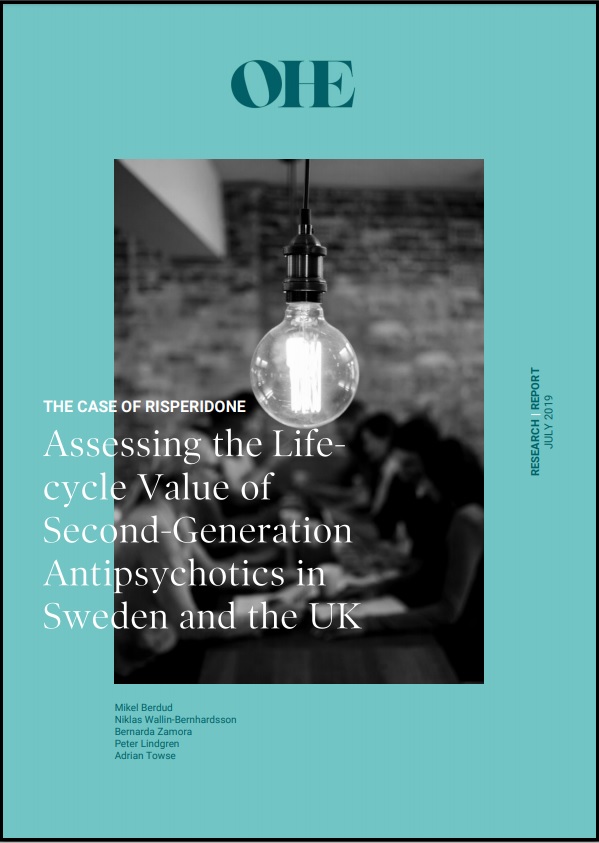The present work aims to assess the life-cycle value of innovative medicines based on the example of Second-Generation Antipsychotics (SGA). Assessing the entire life-cycle of SGA,…
The present work aims to assess the life-cycle value of innovative medicines based on the example of Second-Generation Antipsychotics (SGA). Assessing the entire life-cycle of SGA, the study explores how much additional value has been delivered through additional approved indications for SGAs, generic competition or new and clinically superior formulations launched. Using risperidone as representative of the SGA class and comparing it to haloperidol – its counterpart from the First-Generation Antipsychotics (FGA) – this research estimates the life-cycle cost-effectiveness of the SGA class against FGA class in incremental terms. It also estimates the absolute social value added, measured by the sum of the consumer and producer surpluses. Study results aim to quantify the nature of value added by pharmaceutical innovation over the long-run to support consideration as to how access decisions can be informed by these life cycle effects.
The present work aims to assess the life-cycle value of innovative medicines based on the example of Second-Generation Antipsychotics (SGA). Assessing the entire life-cycle of SGA, the study explores how much additional value has been delivered through additional approved indications for SGAs, generic competition or new and clinically superior formulations launched. Using risperidone as representative of the SGA class and comparing it to haloperidol – its counterpart from the First-Generation Antipsychotics (FGA) – this research estimates the life-cycle cost-effectiveness of the SGA class against FGA class in incremental terms. It also estimates the absolute social value added, measured by the sum of the consumer and producer surpluses. Study results aim to quantify the nature of value added by pharmaceutical innovation over the long-run to support consideration as to how access decisions can be informed by these life cycle effects.
The value to society of pharmaceutical innovation depends on the long-term health and related benefits, net of additional costs. How much society should pay for new medicines, in order to reward and incentivise innovation, has become a crucial question for policy makers. Another important question that has gained attention of all stakeholders is if policy makers should start considering how to quantify and recognise the full value added by innovative medicines over their life-cycle to inform their pricing and reimbursement decisions. Therefore, research to generate accurate estimates of the long-term value that innovative medicines can generate, is important in informing these questions (Lakdawalla et al., 2017; Puig-Junoy, 2018).
The present work aims to assess the life-cycle value of innovative medicines based on the example of Second-Generation Antipsychotics (SGA). Assessing the entire life-cycle of SGA, the study explores how much additional value has been delivered through additional approved indications for SGAs, generic competition or new and clinically superior formulations launched. Using risperidone as representative of the SGA class and comparing it to haloperidol – its counterpart from the First-Generation Antipsychotics (FGA) – this research estimates the life-cycle cost-effectiveness of the SGA class against FGA class in incremental terms. It also estimates the absolute social value added, measured by the sum of the consumer and producer surpluses. Study results aim to quantify the nature of value added by pharmaceutical innovation over the long-run to support consideration as to how access decisions can be informed by these life cycle effects.
This joint research by the Office of Health Economics (OHE) in the UK and the Institute for Health Economics (IHE) in Sweden shows that health systems and societies in general (consumers) were able to appropriate most of the life-cycle value (surplus) generated by SGAs in the UK and Sweden. The value added by the SGA significantly increased with the launch of Risperidone Long-Acting Injectable and even more with the entry of generic competition, as the evolution of the absolute surplus distribution, as well as the Net Monetary Benefit (NMB) and the life cycle Incremental Cost Effectiveness Ratio (ICER) show. This suggests that the life-cycle value added by SGAs to the system was higher than the value that would have been estimated using cost-effectiveness analysis at launch. The latter does not consider generic entry, and the launch of new and more effective presentations and indications.
Consequently, we suggest that pricing and reimbursement decisions should consider how to recognise the dynamic nature of pharmaceutical markets and the full life cycle of value added by innovative medicines. This presents a challenge of estimation, but also of assessing the appropriate share of social value that should go to the producer and to the health system.



